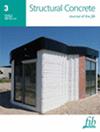手工螺柱嵌入红泥合成粗骨料混凝土的拉拔试验
IF 3.3
3区 工程技术
Q2 CONSTRUCTION & BUILDING TECHNOLOGY
引用次数: 0
摘要
本文介绍了在使用红泥合成粗骨料的混凝土中集中嵌入螺柱的强度能力实验结果,手工制作的带头螺柱厚度(3.17、4.76、6.35 和 7.9 毫米)不同,且与混凝土的粘结力没有影响。有关混凝土抗压强度的结果表明,合成粗骨料的抗压强度显著提高,从 27.00 兆帕到 43.50 兆帕不等,而天然粗骨料的抗压强度则从 27.00 兆帕到 36.50 兆帕不等。此外,还观察到合成粗骨料混凝土基体中的裂缝发生在骨料中,而不是过渡区,这一点与天然粗骨料混凝土相同。然而,合成粗骨料形成的固体形态为带头螺柱提供了极好的化学粘附性,在达到钢筋屈服强度值后,可在更大位移下提供硬化破坏行为。这样就能优化低强度结构混凝土配料中的材料消耗,并以较小的带头厚度(最多为带头直径的 8%)锚固螺柱,从而实现经济性和可持续性。本文章由计算机程序翻译,如有差异,请以英文原文为准。
Pull‐out tests of handcrafted studs embedded in concrete with red mud synthetic coarse aggregate
This paper presented the experimental results of the strength capacity of studs embedded centrally in concrete with red mud synthetic coarse aggregates, with the variation of the handcrafted headed stud thickness (3.17, 4.76, 6.35, and 7.9 mm) and no shank bond influence with concrete. The results regarding the compressive strength of concrete showed considerable strength gain with synthetic coarse aggregate, ranging from 27.00 to 43.50 MPa, while in concrete with natural coarse aggregate, the variation was 27.00 to 36.50 MPa. Also, it was observed that the cracking in the concrete matrix of the synthetic coarse aggregate occurred in the aggregate instead of the transition zone, as occurred with the natural coarse aggregate concrete. However, the solid morphological formation of synthetic coarse aggregate provided excellent chemical adhesion to the headed stud, providing a hardening failure behavior after reaching the yield strength value of the steel bar with higher displacements. This can enable the optimized consumption of materials in the dosage of low‐strength structural concrete and the anchoring application of studs with smaller‐headed thicknesses, up to 8% of head diameter, generating economy and sustainability.
求助全文
通过发布文献求助,成功后即可免费获取论文全文。
去求助
来源期刊

Structural Concrete
CONSTRUCTION & BUILDING TECHNOLOGY-ENGINEERING, CIVIL
CiteScore
5.60
自引率
15.60%
发文量
284
审稿时长
3 months
期刊介绍:
Structural Concrete, the official journal of the fib, provides conceptual and procedural guidance in the field of concrete construction, and features peer-reviewed papers, keynote research and industry news covering all aspects of the design, construction, performance in service and demolition of concrete structures.
Main topics:
design, construction, performance in service, conservation (assessment, maintenance, strengthening) and demolition of concrete structures
research about the behaviour of concrete structures
development of design methods
fib Model Code
sustainability of concrete structures.
 求助内容:
求助内容: 应助结果提醒方式:
应助结果提醒方式:


